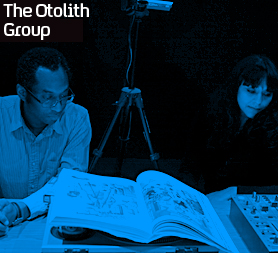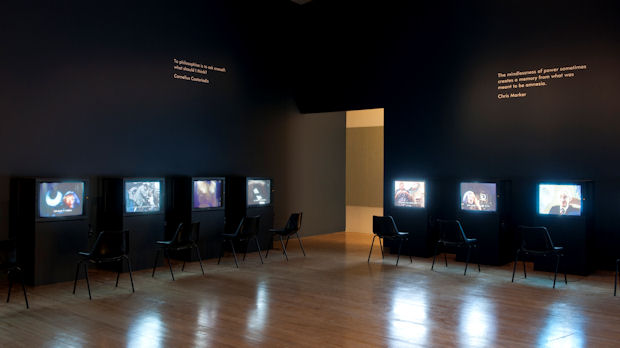Turner Prize 10: The Otolith Group
The Otolith Group is a London-based collaboration working with video, words and workshops in a project to “build a new film culture”. It is the first collective to be nominated for the Turner Prize.

The Otolith Group takes its name from the part of the inner ear which establishes the body’s sense of gravity and orientation.
Founder Kodwo Eshun, who set up the collective in 2002 with Anjalika Sagar, explains: “Calling ourselves The Otolith Group had a facelessness that we really liked. It enabled us to create a relation to traditions that we really respected, the traditions of collective film-making.”
The group integrates film and video-making with artists’ writing, workshops, exhibition curation, publication and the development of public platforms for studying the image in contemporary society.
Eshun was born in London in 1966 and studied English at Oxford in the mid-1980s. Sagar was born two years later and studied Anthropology and Hindi at the School of Oriental and African Studies in London, 1994-97.
The collective was nominated for A Long Time Between Suns, a show which took place at Gasworks and The Showroom, London. For Turner Prize 10 exhibition the group created Inner Time of Television 2010, a film-based body of work which explores Chris Marker’s TV series The Owl’s Legacy in the form of an installation. All thirteen episodes are played simultaneously in the gallery space.
More on The Otolith Group from Turner Prize 10
3 Minute Wonder on Channel 4 until 9 December (Courtesy: Tate Media)
The Otolith Group’s films merge archive footage with newly shot material and fictionalised sequences, moving between the past, present and future to blur the lines between the real and the imagined with a nod to science fiction.
As the narrator of Otolith 1 (2003) puts it: “For us, there is no memory without image. And no image without memory. Image is the matter of memory.”
For us, there is no memory without image. And no image without memory.
Otolith II is (2007) is set in India in the near-future, juxtaposing scenes of Mumbai slums with footage of the Indian advertising agency.
Otolith III (2009), on show at Tate Britain, returns to the 1960s and filmmaker Satyajit Ray’s never-realised screenplay about a boy from a remote Bengali village who makes friends with an alien. Four characters – the boy, an engineer, an industrialist and a journalist – are extracted and given a narrative voice in the contemporary world.

‘An attempt to build a new film culture’
“When you have a group of people working very intensively, a certain kind of concentration and a certain kind of focus is necessary.
“Calling ourselves The Otolith Group had a facelessness that we really liked. It enabled us to create a relation to traditions that we really respected, the traditions of collective film-making.
“Film-making is an inherantly collective practice, whether you admit it or not. We make films, curate exhibitions, we put on discussions. We call all of this in its entirety an ‘integrated practice’.
“Integrated practice is a term that came from the eighties which was the aspiration to not just make films but to build a distribution system and an education system, so it’s really an attempt to build a new film culture.”
“The world doesn’t need any more films, the world doesn’t need any more video art – so you have to think it through.”

(The Otolith Group at Turner Prize 2010, Tate Britain. Photo: Tate Photography)
'Everyone's invited in, you just have to decide whether to embark on the journey,' writes Matthew Cain
The work of the Otolith Group is easily the most challenging on this year's list. But this is an observation rather than a criticism.
So much of contemporary art in 2010 is the equivalent of a one-liner joke. But the problem is that once you've got the joke, it doesn't take you anywhere else.
The work of the Otolith Group does the exact opposite; any kind of appreciation or understanding isn't at first apparent and is only gradually revealed the more time you invest in it.
Which makes it difficult to consider next to the much more accessible work of an artist like Dexter Dalwood. But there's an interesting if unexpected thematic overlap between the two; both bodies of work prompt us to question our pre-conceived notions of truth and history, the real and the imagined.
The academic, drier tone of Otolith III means that it's ultimately less crowd-pleasing. And in this age of unprecedented democratisation of the visual arts, its uncompromisingly cerebral presentation might seem out of place.
But, although I'm a passionate believer in art for all (and, for that matter, art that can be understood by all), I also think that if certain work rewards those passionate enough to invest their intellectual energy into the process of unravelling it, then this shouldn't be frowned upon.
And it's important to point out here that Otolith III is a work which is engaging and inclusive; for the Otolith Group, film-making is a collective practice.
So everyone's invited in. You just have to decide whether or not you want to embark on the journey.